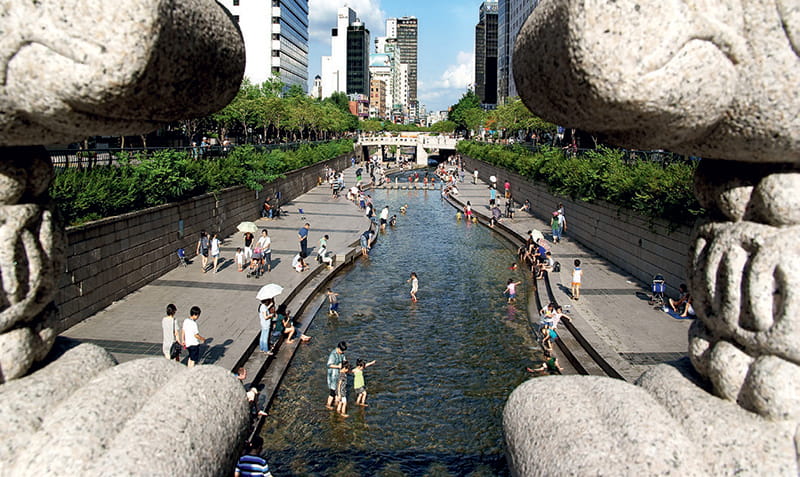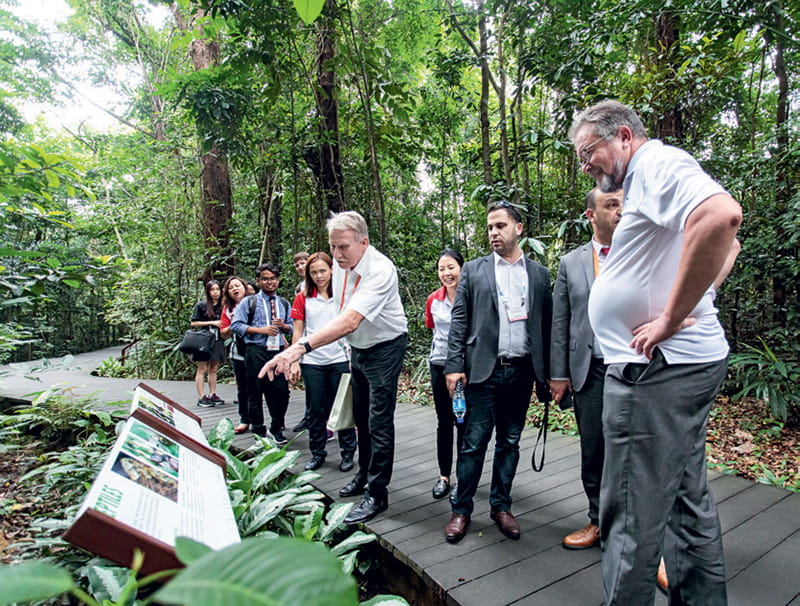Stories > Innovative Urbanism
Innovative Urbanism
A decade since it was established in Singapore, the World Cities Summit continues to provide exemplary solutions to global urban challenges exacerbated by the ongoing pandemic.
BY SHWETA PARIDA
PHOTOS WORLD CITIES SUMMIT, SEOUL METROPOLITAN GOVERNMENT & ISTOCK
he impending fourth industrial revolution is characterised heavily by disruptive technologies that address urban living, climate change and cities’ resilience towards healthcare crises.
The Covid-19 pandemic has exposed the vulnerabilities of both developed and developing cities. It has also revealed the unexplored potential that can collectively address some of the pre-existing urban challenges as well as those that have been laid bare as a result of the pandemic: food sufficiency, mobility and digital disparity.

Seoul, winner of the 2018 Lee Kuan Yew World City Prize, has reimagined its urban design to make it more accessible to the city’s residents. A natural water body has become a social space after the removal of an elevated highway.
The World Cities Summit (WCS) was set up in 2010 to address these common challenges and their solutions. The biennial event, held in conjunction with the Singapore International Water Week and the CleanEnviro Summit Singapore, brings together government leaders and industry experts from around the world to discuss liveable and sustainable city challenges, share integrated urban solutions, and forge new partnerships.
Jointly organised by Singapore’s Centre for Liveable Cities (CLC) and the Urban Redevelopment Authority (URA), key highlights of the conference include the WCS Mayors Forum, the Lee Kuan Yew World City Prize (LKYWCP) and the WCS Young Leaders Symposium.
Urban planning embodies long-term goals for fast-evolving conditions in cities and their impact on the city dwellers. The ongoing discussions focus on the fact that cities not only need economic growth drivers to enhance their liveability but a multi-pronged approach that keeps people at the core.
The latest edition of the WCS, titled “Liveable & Sustainable Cities: Embracing the Future Through Innovation and Collaboration”, saw 133 mayors and city leaders from 129 cities gather to discuss the importance of adopting change, and disruptive innovations that enable cities to improve and thrive.

At the latest WCS Mayors Forum, 133 mayors and city leaders from 129 cities came together to discuss shared challenges and solutions.
“Through the discussions, participating cities also recognised that as we embrace disruptive ideas and technologies, we must keep human betterment and connections at the heart of our cities,” shares Michael Koh, executive fellow, CLC.
CATALYSTS OF CHANGE
One of the highlights of the summit is the LKYWCP, a biennial international award that honours outstanding achievements and contributions to the creation of liveable, vibrant and sustainable urban communities.
The prize, co-organised by the URA and CLC, honours cities and recognises their key leaders and organisations for displaying foresight, good governance and innovation in tackling urban challenges to bring about social, economic and environmental benefits in a holistic way to their communities. The award shines the spotlight not only on major metropolises but also smaller cities that have set the blueprint for organic growth for other cities of similar size and resources. Past winners include Bilbao (2010), New York City (2012) Suzhou (2014), Medellin (2016) and Seoul (2018) (see below).
“Through The Discussions, Participating Cities Also Recognised That As We Embrace Disruptive Ideas And Technologies, We Must Keep Human Betterment And Connections At The Heart Of Our Cities.”—Michael Koh, Executive Fellow, CLC
Sharing the examples of such small cities are Bilbao in Spain and Medellin in Colombia. Koh says: “Bilbao transformed from a dilapidated industrial city into a knowledgebased economy through an integrated and holistic approach. And in Medellin, the Unidades de Vida Articulada [life-articulated units] programme invites citizens to be actively involved in the building of sports, recreational and cultural venues on previously inaccessible plots of land set aside for various utilities.”
A clarion call that is getting louder is the desire for greater citizen participation in the planning, design and development of their communities and cities.
Dr Tri Rismaharini, mayor of Indonesia’s second largest city, Surabaya, walks the talk when it comes to people engagement. “From 5am, I’m out and about communicating directly with citizens. Even young people can submit proposals directly to the [mayor],” she says. The mayoral department engages people in such initiatives as slum rehabilitation, free ambulance services, waste management and street lighting to enhance public security, urban farming, brand-building for small businesses, as well as digital skills for low-income groups.
Clearly, the emphasis has expanded from the “public-private partnership” to include people. “We need a new compact: The ‘4P’ – public-private-people partnership – aligning and working together to make our cities work and become more sustainable,” says Dato’ Maimunah Mohd Sharif, executive director, UN-Habitat.
“We Need A New Compact: The ‘4P’– Publicprivate- People Partnership – Aligning And Working Together To Make Our Cities Work And Become More Sustainable.”
Dato’ Yew Tung Seang, mayor of Penang state in Malaysia, adds a fifth “P” to the equation: for ‘professionals’. “We allocate a session every month with professionals to think of solutions to implement what the people want,” he shares.
DEVELOPMENT AND PRESERVATION
Yet another component of the programme is the WCS Young Leader Symposium, a platform for a select group of 300 changemakers from diverse sectors who shape the global urban agenda. Among them is WCS Young Leader and chairman of sustainability at the Singapore Institute of Architects, Tan Szue Hann.
“The LKYWCP laureate cities set an example for Singapore’s own growth, where our urban development has paralleled the growth of the nation,” he says. “We have had to run some of these developments in parallel – industrialisation and rejuvenation as tools for urban and economic growth, and smart infrastructure in creating objectivity and efficiency.”
However, some among the young leaders caution against brisk development. Justin Lester, the New Zealand politician, entrepreneur and former mayor of Wellington, shares that Wellington went against traditional cost-benefit analyses to preserve and promote New Zealand’s indigenous Maori culture and ancient wildlife, flora and fauna. Over in Europe, Hamburg has successfully regenerated the underused parts of its harbour while respecting its built heritage. These strategic urban interventions have helped to regain more open spaces for the public to enjoy.

International attendees are seen visiting landmarks in Singapore during the latest edition of the World Cities Summit. As a regular feature of the event, these site visits offer visitors an insight into Singapore’s sustainable urban development.
FLEXIBLE AND ADAPTABLE CITIES
One of the major fallouts of the pandemic has been the disruption of the global supply and logistics network, which has reinforced many governments to bolster their food resilience preparedness. This is even more vital for small cities such as Singapore. “The concept of self-sufficiency now hits home, as we have had to source for new international suppliers of basic items such as eggs and rice,” says Tan, referring to the government’s 30 by 30 goal – being 30 per cent self-sufficient in food production by 2030.
With the primary objective of the summit being collective progress through the sharing of ideas and best practices, the WCS has its work cut out for its next edition, which will take place in Singapore in July 2021 under the fresh theme of “Liveable and Sustainable Cities: Adapting to a Disrupted World”.
As such, it will offer virtual components to enable international delegates in different time zones to participate in the event.
“The summit will bring together cities, businesses and experts at the forefront of pressing urban issues to discuss how they can adapt to a disrupted world, which is especially apt in light of the outbreak that has forced cities around the world to react and adapt to the new post-Covid-19 world,” says Koh.
WINNERS OF LEE KUAN YEW WORLD CITY PRIZE |
||
 |
 |
|
BILBAOOnce a run-down industrial precinct, the city’s Abandoibarra district adjacent to the Nervión River has been transformed into a vibrant community, with a focus on cultural, creative and innovationcentric activities. |
NEW YORK CITYPost-9/11, it embarked on regeneration of its underdeveloped districts such as Brooklyn, as well as greening efforts that led to the iconic High Line project that converted a disused rail line into an elevated green park for the city’s residents. |
|
 |
 |
|
MEDELLINThe Columbian city fell into disrepute back in the ‘80s and ‘90s for its rampant crime, drug culture and widespread poverty, but turned itself around with sustainable urban planning to become a role model for other developing cities. |
SUZHOUThanks to its visionary governance and urban planning, the garden city of China has transitioned from being an agrarian society into a highly innovative and serviceoriented one, while still preserving its heritage and culture. |
|
SEOULThe South Korean capital, with the help of technology, has repurposed parts of its existing urban infrastructure to make the city more liveable, sustainable and accessible to its residents. |
 |
|
